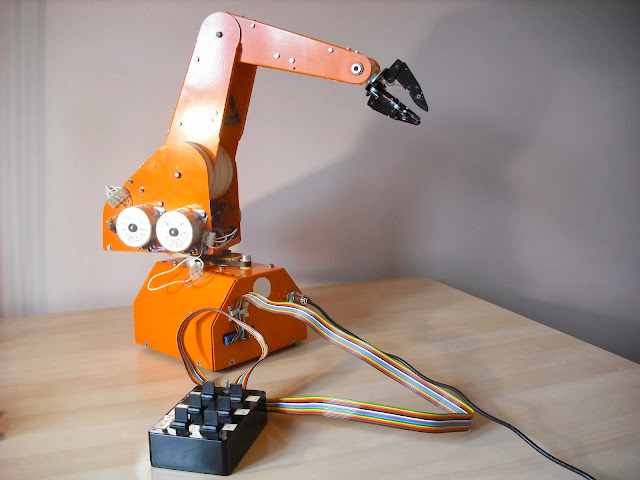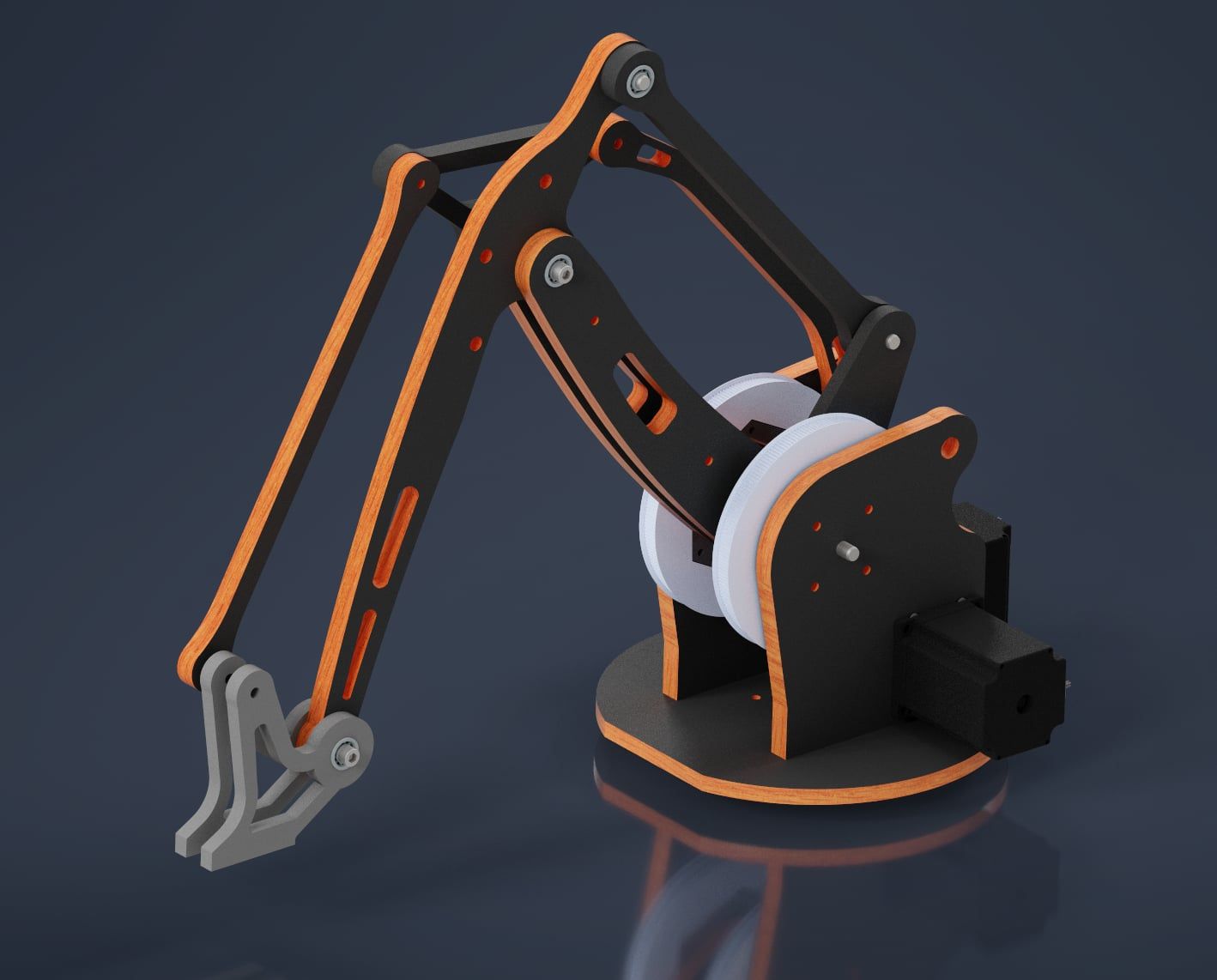4 axis palletized robot arm (robot kinematics) for 3D printing
-
@JoergS5 Ok, I'll wait for it then. If there's something I can help with please let me know
-
@JoergS5 I'm not familiar with screw theory, but I've been reading about it in the Duet3D documentation and searching for relevant papers. I have a strong understanding of geometric algebra, as I am completing my physics degree.
-
@YuriConfessor said in 4 axis palletized robot arm (robot kinematics) for 3D printing:
I have a strong understanding of geometric algebra, as I am completing my physics degree.
That's interesting. I implement the kinematics with screw theory, but for more complex problems like 6 arm industrial robots I use geometric algebra (eg calculating intersections of two circles of two robot arms). Some ideas like quaternion based slerp for a velocity constant rotation of AC axes is part of geometric algebra, so I want to base a segmentation calculation on this theory. This is however not part of the kinematics, but of the core RRF.
For geometric algebra I use the conformal geometric algebra, originated from Hestenes.
Let me implement the easy part 4 axis palletized first and recheck the CoreXY AC. I'm happy to discuss with you about geometric algebra after this. @xyzdims told me about geometric algebra a year ago, he may be interested in participating.
-
@YuriConfessor to add a thought about geometric algebra:
RRF and microcontrollers in general have very limited memory. I failed to implement calculating the geometric product with hash tables, because they need too much memory (4 KB eg is too much already). I calculate most of the geometric product, and make manual calculations into using only the used values of the sparse 32-value-Conformal-Geometry. If you can help and have ideas in this area, this would be helpful. But in other areas as well, of course.
-
@JoergS5 Is my Armdroid (1980s cable-strung robot arm) a '4 axis palletized robot arm'? I think it is. It has six motors, the assignments are:
Motor 1 - base rotation
Motor 2 - shoulder
Motor 3 - forearm
Motor 4 - left wrist
Motor 5 - right wrist
Motor 6 - gripperWhen the wrist motors are run in the same direction, the wrist moves up and down, when run in opposite directions, the wrist rotates.
It looks like this:

If so, looking forward to your firmware update, and getting it moving in the New Year! Happy to do any testing. I have a 6HC or a Mini 5+ with Mini 2+ I can put in it.
Ian
-
@JoergS5 said in 4 axis palletized robot arm (robot kinematics) for 3D printing:
That's interesting. I implement the kinematics with screw theory, but for more complex problems like 6 arm industrial robots I use geometric algebra (eg calculating intersections of two circles of two robot arms). Some ideas like quaternion based slerp for a velocity constant rotation of AC axes is part of geometric algebra, so I want to base a segmentation calculation on this theory. This is however not part of the kinematics, but of the core RRF.
For geometric algebra I use the conformal geometric algebra, originated from Hestenes.I will try to deepen my knowledge of algebra so that it can be applied to robotics. I confess that I have only used it within the study of physics, so I am excited to be able to apply my learning in a more practical way. I have heard of Hestenes; during my undergraduate studies, I was recommended one of his books, "Clifford Algebra to Geometric Calculus".
-
@JoergS5 I think I can probably help with it, just need to understand what progress you've made so far and learn a little bit better about RRF microcontrollers
-
@droftarts the specific property of the 4 axis palletized robot is that there is a parallelogram structure in the middle which makes sure that the beginning reference line is the same like at the endpoint, i.e. through construction a constraint is added to asure a specific orientation (the endpoint always being horiziontal in this case).
The parallelogram construction helps for heavy weights also, my favorite is ABB IRB 8700. A "bit" too expensive for me.
I think your robot is different, however very interesting. When I understand what wrist means and which parts move/rotate, I can support to add a kinematics for it.
-
@JoergS5 thanks for the explanation. I can’t remember if this arm keeps the endpoint (ie the gripper) in the same orientation as the other joints move, but I think it does, at least within its normal range of movement. ‘Wrist’ is the joint the gripper sits on, and allows for orientation of the gripper separately from the forearm.
Excited to potentially have this arm under control for the first time in a couple of decades!
Ian
-
@droftarts I found a 4 axis palletizing robot from Sainsmart for 99$
With my CO2 lasercutter and some decent plywood or acrylic sheets, I think I could make a RRF version for steppers. (although those MG995 servos are hard to beat cost/power-wise)
@JoergS5 Your robot kinematics expect a step/dir interface, I guess?

-
@o_lampe that looks interesting. From a quick look at the pictures, the extra linkages are doing the same (probably a better) job as the cables in my arm.
Ian
-
@droftarts As JoergS5 already said: the linkages make sure that the toolhead is always horizontal. Your arm has some deluxe options which are not palletizing-compatible.
-
@o_lampe right I get it now. The tool head is kept horizontal (or vertical) and there’s no control over that. My arm has the extra controllable wrist joint, which makes it a five or six axis arm, I suppose. If I ignore that for now, I think I can still test the 4 axis palletised firmware.
Ian
-
@o_lampe said in 4 axis palletized robot arm (robot kinematics) for 3D printing:
robot kinematics expect a step/dir interface, I guess
the kinematics is integrated in RRF like the other kinematics. So the capabilites in respect to controlling interfaces are the same.
The Sainsmart has no parallelogram, but I analyzed it some time ago: the triangle on top has the same function, when thinking through the angles. Some of the commercial big robots use the same triangle construction (Kuka KR 700 eg).
Two parallelograms, conntected with a fixed triangle. Advantage: arms can be "bent down", disadvantage: more hinges, probably with play = less precision. For 3D printers, it may be better to construct it with a true parallelogram and the actuators higher placed.
-
If someone is interested to 3D print a 4 axis palletized, the MeArm 3.0 on Thingiverse https://www.thingiverse.com/thing:3420797 seems to be one. I'll take this for me to build one. I work this weekend on the firmware implementation.
A fork with steppers: https://www.thingiverse.com/thing:970881
There are other versions, searchable by MK2 design or Kuka 180 (= Kuka KR 180 PA). -
@JoergS5 I found another one with NEMA17 motors, but it's quite outdated.
It uses spur gears instead of GT2 belts, which would be the minimum requirement for me to build one.
-
Hello guys, I've been able to include the DH parameters directly to the gcode by creating a slicer using grasshopper. But this solution is not pratical in any form. @JoergS5 is it possible to launch a firmware with the DH enabled on the K13 so I can figure the robot directly on the config file? I'm using a cartesian kinematics and tricking the machine with the gcode. Here is a short video of it "building" a cillinder: lRobot kinda working
-
@YuriConfessor I will provide an unfinished version on Feb 24/25 for your printer type, which is missing some features like velocity/angle checks. I'll provide a Duet 2 binary for you.
-
@JoergS5 Ok, thank you! I'll post here if I have any updates
-
Any uppdates on this? Im trying to get inverse kinematics working on the same type of robot.
I might be wrong but this should be a serial scara but when axis 1 moves axis 2 need to follow to keep the relative angle (axis 1 to 2) the same? the relative move should be a 1:1 = just add axis 1 moves to axis 2?
